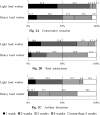An awareness survey of surgeons involved in breast cancer treatment regarding their patients returning to work
- PMID: 25741040
- PMCID: PMC4345690
An awareness survey of surgeons involved in breast cancer treatment regarding their patients returning to work
Abstract
Surgeons focus on the period of absence from work during the initial treatment of breast cancer. The aim of this study was to determine surgeons' perceptions and awareness regarding the necessary period of absence from work during breast cancer treatment. We created a questionnaire for all surgeons involved in breast cancer treatment who are affiliated with the Department of Surgery at the Nagoya University Graduate School of Medicine and its associated facilities. The necessary leave of absence period for each treatment was considered, and the decision regarding whether patients should return to work was examined. The surgeons were instructed to assume that a 'heavy load worker' was a nurse or caregiver and that a 'light load worker' was a medical office worker. This study included 184 surgeons (response rate: 96.8%). More than half of the surgeons considered that light load workers could return to work within 2 weeks; 89.8% after conservative resection, 71.6% after total mastectomy, 50.3% after axillary dissection. In contrast, more than half of the surgeons considered that heavy load worker should wait returning to work more than 3 weeks; 49.4% after conservative resection, 73.3% after total mastectomy, 85.7% after axillary dissection. For patients treated with chemotherapy, three-quarters of the surgeons indicated that it would be difficult to work while receiving anthracycline regimens. The results suggest that surgeons can predict the approximate period of absence from work for patients who receive an initial treatment of breast cancer.
Keywords: breast cancer survivors; period of absence from work; return to work.
Figures


Similar articles
-
Breast conserving surgery versus mastectomy: cancer practice by general surgeons in Iran.BMC Cancer. 2005 Apr 5;5:35. doi: 10.1186/1471-2407-5-35. BMC Cancer. 2005. PMID: 15811187 Free PMC article.
-
Correlates of referral practices of general surgeons to plastic surgeons for mastectomy reconstruction.Cancer. 2007 May 1;109(9):1715-20. doi: 10.1002/cncr.22598. Cancer. 2007. PMID: 17387715
-
Breast irradiation in women with early stage invasive breast cancer following breast conservation surgery. Provincial Breast Disease Site Group.Cancer Prev Control. 1997 Aug;1(3):228-40. Cancer Prev Control. 1997. PMID: 9765748
-
How Can We Improve Education of Breast Surgeons Across Europe?Chirurgia (Bucur). 2017 Jul-Aug;112(4):365-366. doi: 10.21614/chirurgia.112.4.365. Chirurgia (Bucur). 2017. PMID: 28862111 Review.
-
A survey of general surgeons' attitudes towards breast reconstruction after mastectomy.Ann R Coll Surg Engl. 1998 May;80(3):178-83. Ann R Coll Surg Engl. 1998. PMID: 9682639 Free PMC article. Review.
Cited by
-
Correlation between ultrasonic features and expression levels of C-erbB-2, VEGF and nm23 in breast cancer.Oncol Lett. 2018 Aug;16(2):1701-1707. doi: 10.3892/ol.2018.8777. Epub 2018 May 22. Oncol Lett. 2018. PMID: 30008856 Free PMC article.
-
Costs and effects of intra-operative fluorescence molecular imaging - A model-based, early assessment.PLoS One. 2018 Jun 1;13(6):e0198137. doi: 10.1371/journal.pone.0198137. eCollection 2018. PLoS One. 2018. PMID: 29856875 Free PMC article.
References
-
- Bloom JR, Stewart SL, Chang S, Banks PJ. Then and now: quality of life of young breast cancer survivors. Psychooncology 2004; 13: 147–60. - PubMed
-
- Maunsell E, Drolet M, Brisson J, Brisson C, Mâsse B, Deschênes L. Work situation after breast cancer: results from a population-based study. J Natl Cancer Inst 2004; 96: 1813–22. - PubMed
-
- van der Wouden JC, Greaves-Otte JG, Greaves J, Kruyt PM, van Leeuwen O, van der Does E. Occupational reintegration of long-term cancer survivors. J Occup Med 1992; 34: 1084–9. - PubMed
-
- Kagawa-Singer M. Redefining health: living with cancer. Soc Sci Med 1993; 37: 295–304. - PubMed
LinkOut - more resources
Full Text Sources
